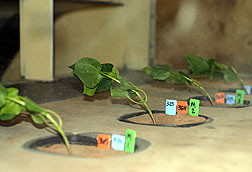This page has been archived and is being provided for reference purposes only. The page is no longer being updated, and therefore, links on the page may be invalid.
|
|
|
|
|
|
ARS Studies Effect of Wind Sandblasting on Cotton Plants
By Don ComisJanuary 26, 2010
Someday breeders will be able to choose cotton plants that can better withstand wind sandblasting, according to an Agricultural Research Service (ARS) scientist.
ARS plant physiologist Jeff Baker has been testing the effects of wind sandblasting on cotton seedling growth. His goal is to develop plants that can heal faster and maintain yields after suffering sandblasting damage.
Baker, based at the ARS Wind Erosion and Water Conservation Research Unit at Big Spring, Texas, is studying the effects of wind sandblasting not only on stems and leaves, but on plant roots.
Big Spring is in the heart of Dust Bowl country, where localized dust storms still sandblast crop seedlings, just as widespread dust storms did during the 1930s and 1950s. The strong wind season begins in November and ends in May each year. The erosive winds, often reaching speeds of 25 to 40 miles per hour, pick up loose particles of soil. The effect on seedlings is similar to the effects of using a mechanical sandblaster on a plant.
Using a wind tunnel, Baker and colleagues blasted seedlings with sand-laden 30-mile-per-hour wind. They studied the effects immediately and after two and four weeks. They found that over the first two weeks, the seedlings shifted their growth from root and leaf growth to repair and growth of injured stems. By the fourth week, plant growth had returned to normal, once again balancing growth throughout the plant, down to the roots.
Wind sandblasting has effects similar to those of pruning—the loss of leaves and reduced photosynthesis. But unlike pruning, windblown sand abrasion damage ruptures plant cells, exposing the plant to temporary drought effects induced by resulting increased plant respiration rates and possible damage to the tiny openings on the outer layer of young plant stems and leaves, called stomates.
More tests are needed of the effects of sand abrasion damage on cotton plants' net photosynthesis and respiration to understand the underlying physiological mechanisms of plant injury and recovery.
This research was published in the Agronomy Journal.
ARS is the principal intramural scientific research agency in the U.S. Department of Agriculture.


